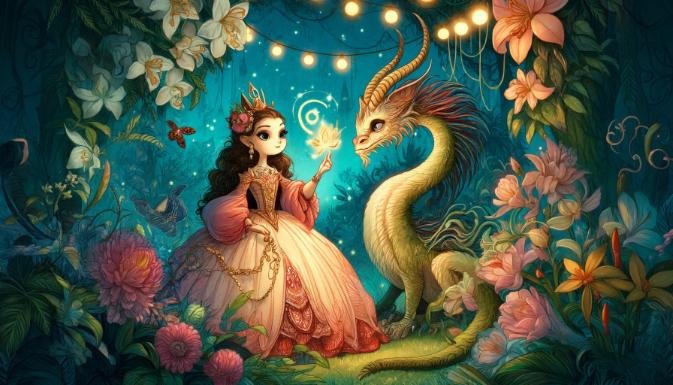In a time where beauty often dictates one’s destiny, there is a story that challenges this superficial notion and takes us on a voyage to discover the true essence of love and happiness. “The Ugly Princess” is a tale that weaves the themes of inner beauty and true love into the rich tapestry of Romanic folktales.
Let this enchanting story of “The Ugly Princess” transport you to a world where the truest form of beauty emanates from within, unfolding a narrative that has captivated hearts for generations and continues to inspire those who believe in the power of kindness and the purity of love.
What is the story of The Ugly Princess?
Once upon a time, in a land graced by the touch of magic and wonder, lived Princess Olive. Unlike the fair maidens of lore, she was born without the gift of outward beauty. Yet, what she lacked in appearance, she possessed tenfold in compassion and wisdom.
Her tale begins when her kingdom announces a quest for her hand in marriage. Many princes sought the hand of the princess, not for love, but for the power and wealth it promised. This journey of trials and tribulations leads the princess to realize that true love cannot be found in shallow waters, but in the depths of one’s heart.
Amidst her search for happiness, she encounters Peter, the humble gardener whose kindness and genuineness capture her heart. Their unlikely friendship blossoms into love, setting the stage for a story that defies the norms of traditional beauty.
The narrative unfolds as they confront societal expectations and personal insecurities, proving that the most profound connections are those unmarred by the superficial judgments of the world.
As “The Ugly Princess” navigates her path to self-acceptance and mutual affection, she teaches us that the most treasured beauty is found in the goodness we nurture within ourselves and share with others.
How does inner beauty play a role in The Ugly Princess?
Throughout the narrative of “The Ugly Princess,” inner beauty is not just a theme, but the beacon that guides the characters towards their ultimate fulfillment. It is the inner glow of Princess Olive’s character that outshines the superficial and earns her the love of those around her.
In this tale, we learn that kindness, empathy, and the courage to be oneself are the truest measures of beauty. These virtues become the catalysts for change and acceptance, not only for the Ugly Princess but for all those touched by her story.
The tale illustrates that when one’s inner light is allowed to shine, it can illuminate the darkest of places and warm the coldest of hearts. It is this moral core that resonates throughout Romanic folktales and continues to inspire readers to look beyond the mirror and into the soul.
Inner beauty plays the pivotal role in transforming how the characters perceive themselves and each other, ultimately leading to a love that transcends physical appearances and societal labels.
As the folktale unfolds, we see the transformation not just of the Ugly Princess, but of those who witness her inner beauty, proving that the power of a kind heart and a loving spirit can change the world one person at a time.
Who are the characters in The Ugly Princess folktale?
- Princess Olive – The protagonist of our story, whose lack of physical beauty is overshadowed by her compassionate spirit and benevolent heart.
- Peter the gardener – A humble and kind-hearted soul who sees the true beauty within the princess and becomes the unexpected suitor.
- The superficial suitors – Princes and noblemen drawn to the princess’s wealth and status, blind to the riches of her inner beauty.
- The royal parents – The king and queen who desire happiness for their daughter but are bound by the societal norms of their time.
- The citizens of the kingdom – The onlookers whose perceptions evolve as the story of the Ugly Princess unfolds, learning to value the beauty that lies within.
These characters serve as mirrors to the various facets of society, reflecting our own biases, judgments, and potential for growth. They are the vessels through which the story imparts its timeless lessons on beauty, love, and happiness.
What moral lessons can we learn from The Uly Princess?
The story of “The Ugly Princess” is rich with moral lessons that are as relevant today as they were in the times of old. At its heart, it teaches us that the true measure of a person lies not in their appearance but in the quality of their character.
It imparts the wisdom that love based on physical attraction is fleeting, whereas love rooted in respect and genuine connection is enduring. The princess’s journey is a testament to the idea that self-acceptance is the first step towards finding true happiness and love.
The narrative also explores the concept that true beauty emanates from acts of kindness and generosity, and that these virtues have the power to transform not only oneself but those around us.
Furthermore, the story serves as a reminder that societal norms and expectations often blind us to the treasures of individual uniqueness and that breaking free from these constraints opens the door to a more fulfilling life.
The folktale encourages readers to look beyond the superficial and to embrace the diversity of beauty that exists in the world, fostering a sense of empathy and inclusiveness.
Are there different versions of The Ugly Princess story?
As with many beloved folktales, “The Ugly Princess” has been told and retold across cultures and generations, each rendition adding its own nuances and insights. These different versions reflect the cultural contexts from which they emerge, yet the core themes of inner beauty and true love remain steadfast.
In some narratives, the princess undertakes a physical transformation, while in others, it is the perception of the people around her that changes. Each version brings a fresh perspective to the story, allowing new lessons to be gleaned and new interpretations to be explored.
Whether it’s in the format of a simple bedtime story, a classical piece of literature, or even a modern manga adaptation like KENGAI PRINCESS, the essence of The Ugly Princess’s journey continues to resonate and adapt to the times.
The existence of these different versions underscores the universality of the tale’s message and its ability to connect with audiences across the spectrum of human experience.
The beauty of these variations lies in their collective testament to the enduring appeal of the folktale and its ability to inspire, challenge, and comfort readers around the world.
What makes The Ugly Princess a timeless folktale?
The timeless nature of “The Ugly Princess” is rooted in its exploration of universal themes that transcend cultural and temporal boundaries. It is a story that speaks to the human condition and the innate desire for acceptance and love.
Its timelessness is evident in its continued relevance; the story reflects ongoing conversations in society about beauty standards, self-worth, and the true meaning of happiness. It serves as a reminder that in a world where outward appearances often dominate, the virtues of the heart are what truly endure.
“The Ugly Princess” resonates with the core of our being, teaching us that everyone has value, and that love and kindness can overcome the most formidable of barriers.
The folktale’s adaptability to various media, from oral traditions to written narratives and visual interpretations, demonstrates its versatility and the wide appeal of its message.
In a world increasingly preoccupied with the superficial, the Romanic folktale of The Ugly Princess continues to offer a beacon of hope, illuminating the path to a more empathetic and authentic existence.
Children and adults alike are drawn to the heartwarming story of Princess Olive and Peter the gardener, finding solace and inspiration in their tale of love and acceptance. As we turn the pages of this enchanting folktale, we are reminded that the most profound beauty is that which dwells within us, waiting to be recognized and celebrated.


Leave a Reply